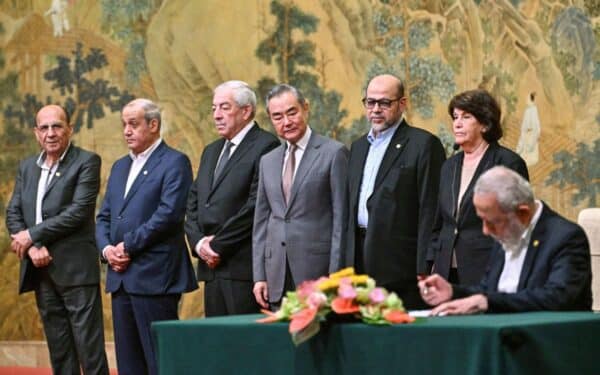“Today, every inhabitant of this planet must contemplate the day when this planet may no longer be habitable,” US President, John F. Kennedy, warned in a speech before the UN in 1961. “Every man, woman and child lives under a nuclear Sword of Damocles, hanging by the slenderest of threads, capable of being cut at any moment by accident, or miscalculation, or by madness.”
Just months later, the Cuban Missile Crisis would bring the world closer to total atomic annihilation than at any point in history, as Washington and the Soviet Union squared off over warheads stationed in the Caribbean. Six decades on though, with Russia facing a string of defeats in its increasingly catastrophic invasion of Ukraine, many are once again contemplating whether nuclear Armageddon could be on the cards.
President Vladimir Putin’s decision to draft ordinary Russians onto the frontlines, despite growing domestic dissent, has widely been seen as a sign of desperation. Unable to hold back a fierce counteroffensive from Ukrainian defenders, and having “annexed” swathes of the neighbouring country following sham referendums, the question is just how far he will go to pursue his expansionists ambitions – and whether he could deliberately or inadvertently oversee the first nuclear exchange since WWII.
Accident
In a tent somewhere behind the front lines, a dosimeter starts ticking up. Specially-trained Ukrainian radiological personnel scramble to work out why. Then the calls start coming in – across the border in Poland, in Lithuania, maybe even in Finland, others are seeing the same readings. Satellite imagery confirms it: a long plume of radioactive smoke is billowing out of the Zaporizhzhia nuclear power plant, Europe’s largest. Only 350 miles south east of Chernobyl, the site of the world’s worst atomic energy disaster, history is repeating itself.
That nightmarish spectre of atomic fallout has long loomed over Putin’s war – but just how likely is it?
In March, a fortnight after the tanks began rolling across the border, bombs started raining down on the Zaporizhzhia site, and its six light water reactors. With Russian troops turning the complex into a conflict zone, there have consistently been fears that a misplaced rocket could create a colossal tragedy.
However, Cheryl Rofer, a retired American nuclear scientist who spent decades working on cleanup operations across the former Soviet Union, has sought to assuage concerns that fighting around the complex could give rise to an atomic blast. “The reactors all have outer concrete containment structures that can sustain a hit from a 20-tonne airplane,” she told me earlier this year. “There is no way to cause a nuclear explosion – like a nuclear bomb – with reactors.”
Held by the Russians for more than six months and operated by Ukrainian staff held hostage there, the Zaporizhzhia nuclear power plant has now been fully disconnected from the grid and its last working reactor has been switched off. Despite that, there are still significant threats to the site, with shortages of staff and heavy shelling taking out power lines. “This is an unsustainable situation and is becoming increasingly precarious,” the International Atomic Energy Agency said in a statement following their visit to the plant last month.
At the same time though, footage smuggled out of the occupied power station has shown a significant presence of Moscow’s troops, including military transport trucks parked close to the walls of the reactor building. This has led to speculation that the Kremlin could be preparing an attack on its infrastructure and, as Ukrainian forces make gains in Zaporizhzhia region, the chances that the Russians choose not to leave quietly is growing.
The consequences of such a step are impossible to forecast, but meteorological models have previously indicated a release of radiation could blow back across occupied eastern Ukraine, Belarus and even Russia, rather than across Western Europe. The nature and the scale of the humanitarian crisis could, quite literally, depend on how the wind blows.
Miscalculation
It would be a big bang, like many others on the battlefield, but the world would stop in its tracks. A “tactical” nuclear warhead, fired from a warship in the Black Sea, from a rocket launcher or out of an artillery cannon, could have a blast radius just 10% of the size of the bomb dropped by the US on Hiroshima in WWII, but would be the first time since 1945 atomic weapons had been used in a war.
Running out of tools in his arsenal to give his troops an edge in Ukraine, there have been repeated predictions that Putin could deploy the one piece of hardware Kyiv doesn’t have. Dr Patricia Lewis, who leads on international security for Chatham House, told the BBC last week that the Russians “might not see it as crossing this big nuclear threshold. They could see it as part of their conventional forces.”
The West has, by all accounts, tried to make it clear that upping the ante with any kind of atomic weapons would be a dangerous miscalculation. According to US President Joe Biden, such a move would “change the face of war unlike anything since World War Two,” but has been coy about what his country’s response would be.
Despite that, there have now been numerous reports that Russia’s nuclear-capable forces are on the move, with vehicles and hardware belonging to the 12th Main Directorate of the Russian MoD, charged with delivering atomic munitions, said to be on trains rolling towards Ukraine.
On Monday, The Times cited NATO sources who warned that the Kremlin could be preparing to test a nuclear weapon close to the border with Ukraine as a show of strength. Whether stopping short of using a tactical device against their foes would prevent serious repercussions is unclear, but it’s a gamble that Putin could easily be eyeing.
If it backfires, and the West deems the escalation to be a serious threat, it is conceivable that NATO allies could step up their support for Ukraine and even begin striking Russian targets directly. The roar of American warplanes in the skies over the Donbass would likely shrink the life expectancy of Putin’s forces there from weeks and months, to just days. Whether he would respond with more nukes, however, is a question that will be keeping commanders on both sides up at night.
Madness
Somewhere deep inside the bunkers of Colorado’s Cheyenne Mountain Complex, a NORAD operator sounds the alarm. Lighting up on the map is a single nuclear missile, designed to create an electromagnetic blast that would take out American communications and military signals. After it, comes a barrage of hundreds more rockets, equipped with deadly warheads trained on urban areas – Los Angeles, New York, Washington DC. In their silos, US atomic weapons operators turn their keys and enter their codes. Three decades after the end of the Cold War, the world descends into nuclear hellfire.
The doomsday scenario is one etched on the minds of the generation who lived through the Cuban Missile Crisis. But could it be imminent once again? Ahead of the invasion in February, Putin put Russia’s atomic forces on high alert, sparking fears he could be posturing in an effort to warn the West off intervention.
Many nations with atomic capabilities see them solely as a deterrent, and are committed to never using them first. However, in its military doctrine, Russia “reserves the right to use nuclear weapons” either in response to an atomic attack, or in case a conventional war means the “very existence of the state is in jeopardy.”
Given the self-proclaimed annexation of the Donetsk, Luhansk, Zaporizhzhia and Kherson regions of Ukraine make them, in Moscow’s view, part of the Russian state, it’s not inconceivable that Putin could argue that test is met if they are conquered. In his speech at a ceremony marking the supposed incorporation of the four regions into Russia last week, he sought to remind the world of the scale of his nuclear arsenal, insisting talk of its use “is not a bluff.”
However, ordering such a pyrrhic and pointless onslaught is one thing, but whether it would be followed through is another. The Russian president may decide he wants to go out in a blaze of glory, but whether his top brass would go along with it and pass on the necessary orders is questionable – effectively wiping their country off the map and ending the world as we know it. Pressing the proverbial button could lead to nuclear Armageddon, but it could equally lead to a top security official simply putting a bullet in Putin’s brain and ending the madness.
With no good options on the table as his armies take beating after beating, losing territory the Kremlin now formally claims as its own, there is evidently a risk of serious escalation. The chances of nuclear war might still be low, but the fact they’re being openly discussed is a worrying sign that Putin is becoming increasingly unpredictable.
Write to us with your comments to be considered for publication at letters@reaction.life




